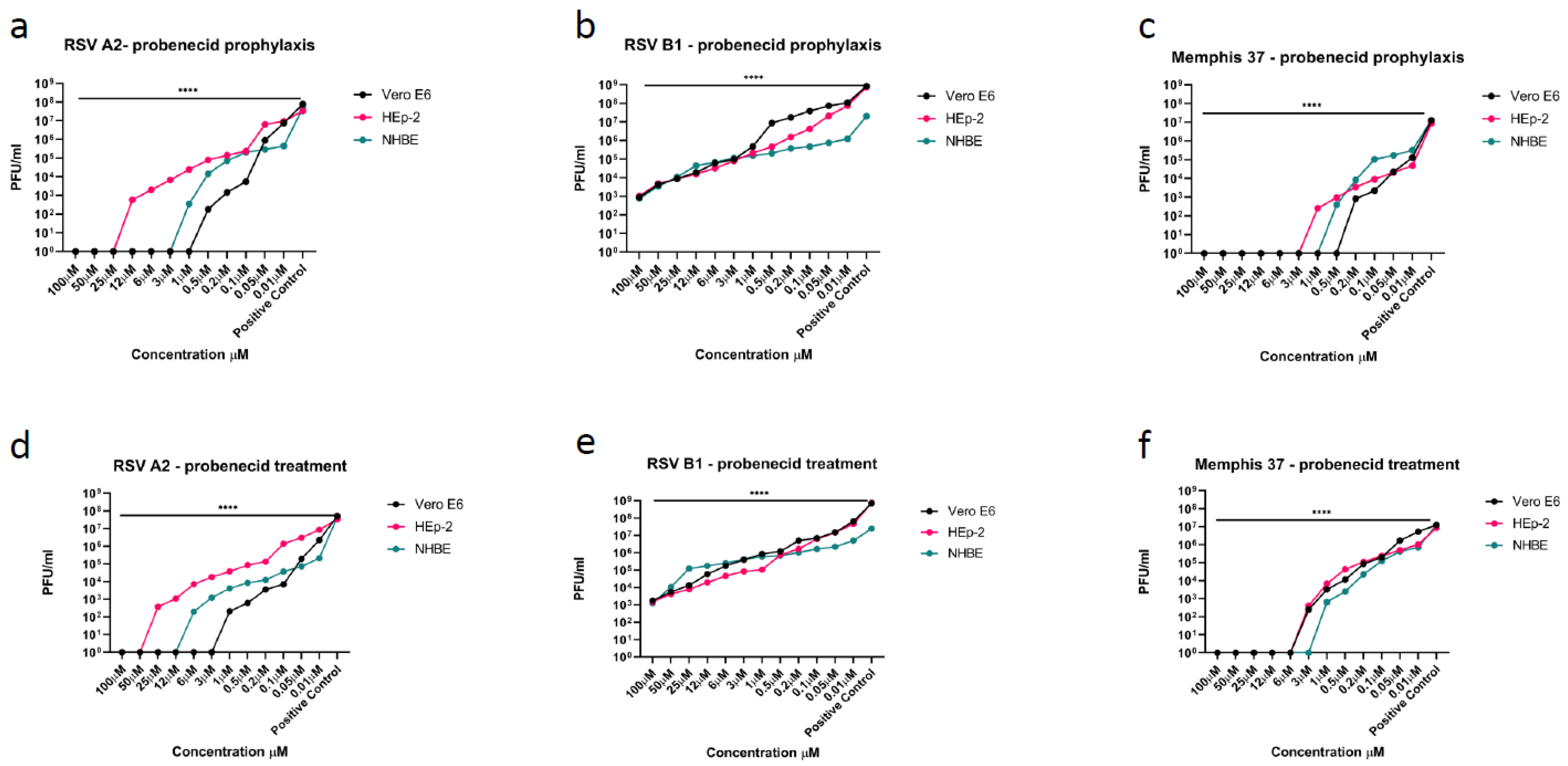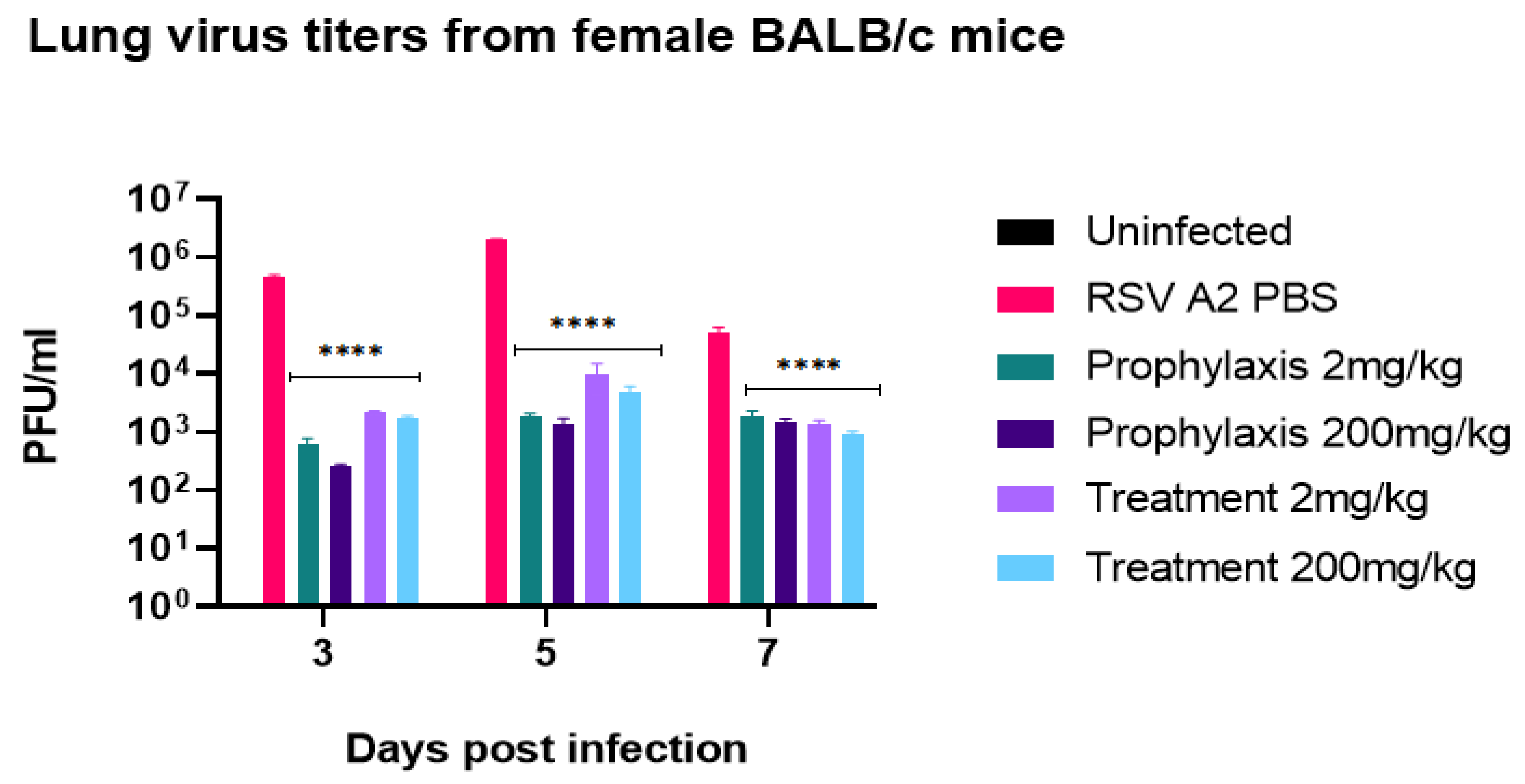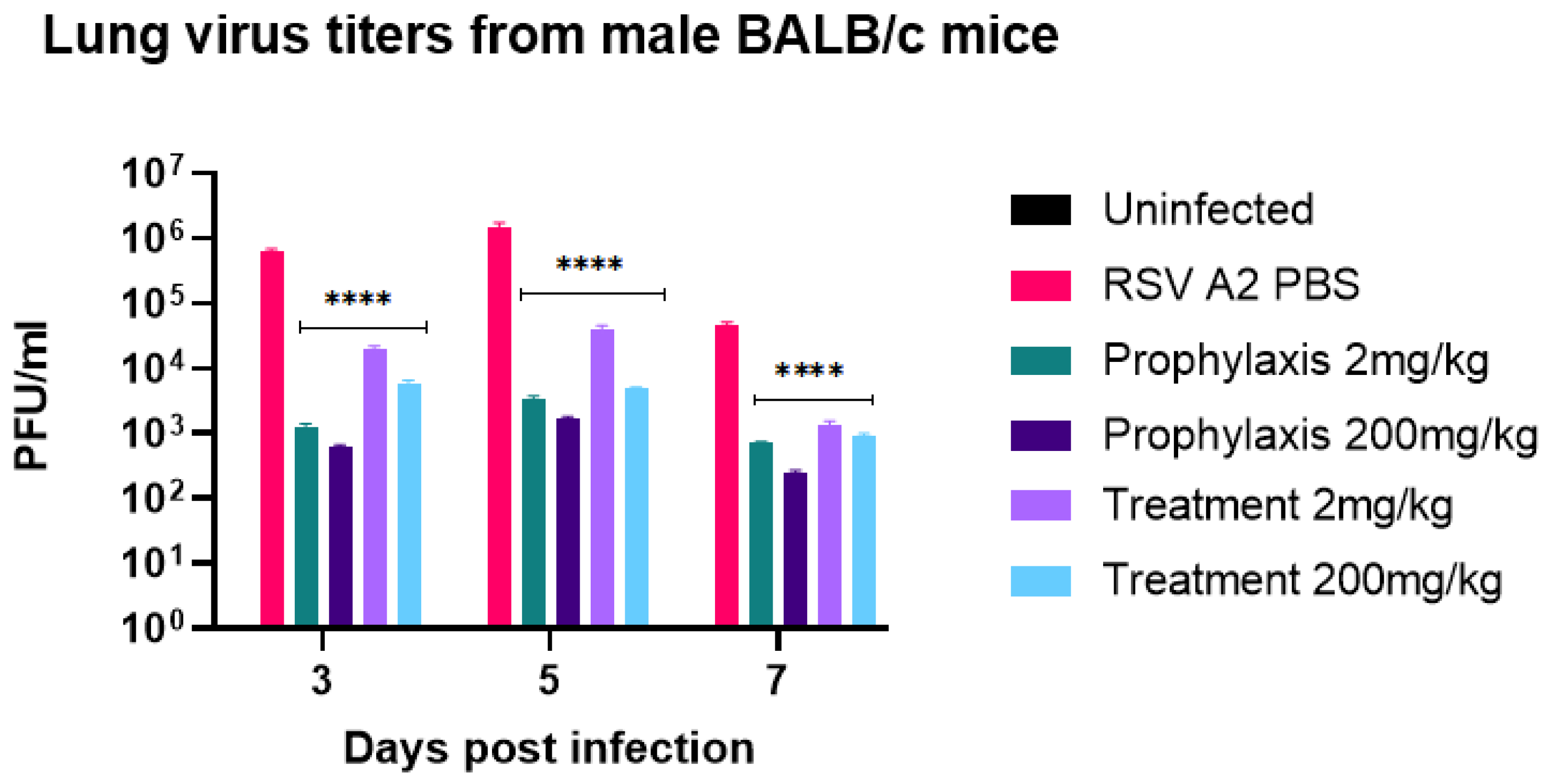Probenecid Inhibits Respiratory Syncytial Virus (RSV) Replication
Abstract
1. Introduction
2. Materials and Methods
2.1. Cells and Cell Culture
2.2. Viruses
2.3. In Vitro Probenecid Inhibition Assays
2.4. In Vivo Inhibition Studies
2.5. Lung Virus Titers
2.6. OAT3 Expression
| Gene | Primer Left (5’-3’) | Primer Right (5’-3’) |
| SLC22A8 (huOAT3) | TGCAAATGAATGCGAATGAGG | CGGTCGTCGCATAACACATA |
| ACTB (huB-actin) | CATGTACGTTGCTATCCAGGC | CTCCTTAATGTCACGCACGAT |
| SLC22A8 (msOAT3) | CATACTCACTCCTGCACTCATC | CCAGGGAATCTCAAAGGGAAA |
| ACTB (msB-actin) | CAGCCTTCCTTCTTGGGTATG | GGCATAGAGGTCTTTACGGATG |
2.7. Statistical Analysis
3. Results
4. Discussion
Supplementary Materials
Author Contributions
Funding
Institutional Review Board Statement
Data Availability Statement
Conflicts of Interest
References
- Welliver, R.C., Sr.; Checchia, P.A.; Bauman, J.H.; Fernandes, A.W.; Mahadevia, P.J.; Hall, C.B. Fatality rates in published reports of RSV hospitalizations among high-risk and otherwise healthy children. Curr. Med. Res. Opin. 2010, 26, 2175–2181. [Google Scholar] [CrossRef] [PubMed]
- Falsey, A.R.; Hennessey, P.A.; Formica, M.A.; Cox, C.; Walsh, E.E. Respiratory syncytial virus infection in elderly and high-risk adults. N. Engl. J. Med. 2005, 352, 1749–1759. [Google Scholar] [CrossRef] [PubMed]
- Thampi, N.; Knight, B.D.; Thavorn, K.; Webster, R.J.; Lanctot, K.; Hawken, S.; McNallr, J.D. Health care costs of hospitalization of young children for respiratory syncytial virus infections: A population-based matched cohort study. CMAJ Open 2021, 9, E948–E956. [Google Scholar] [CrossRef] [PubMed]
- Turner, T.L.; Kopp, B.T.; Paul, G.; Landgrave, L.C.; Hayes, D., Jr.; Thompson, R. Respiratory syncytial virus: Current and emerging treatment options. Clinicoecon. Outcomes Res. 2014, 6, 217–225. [Google Scholar] [CrossRef]
- Foolad, F.; Aitken, S.L.; Shigle, T.L.; Prayag, A.; Ghantoji, S.; Ariza-Heredia, E.; Chemaly, R.F. Oral Versus Aerosolized Ribavirin for the Treatment of Respiratory Syncytial Virus Infections in Hematopoietic Cell Transplant Recipients. Clin. Infect. Dis. 2019, 68, 1641–1649. [Google Scholar] [CrossRef]
- Olchanski, N.; Hansen, R.N.; Pope, E.; D’Cruz, B.; Fergie, J.; Goldstein, M.; Krilov, L.R.; McLaurin, K.K.; Nabrit-Stephens, B.; Oster, G.; et al. Palivizumab Prophylaxis for Respiratory Syncytial Virus: Examining the Evidence around Value. Open Forum Infect. Dis. 2018, 5, ofy031. [Google Scholar] [CrossRef]
- Moore, H.C.; de Klerk, N.; Richmond, P.C.; Fathima, P.; Xu, R.; Keil, A.D.; Snelling, T.L.; Strunk, T. Effectiveness of Palivizumab against Respiratory Syncytial Virus: Cohort and Case Series Analysis. J. Pediatr. 2019, 214, 121–127.e121. [Google Scholar] [CrossRef]
- Bawage, S.S.; Tiwari, P.M.; Pillai, S.; Dennis, V.A.; Singh, S.R. Antibiotic Minocycline Prevents Respiratory Syncytial Virus Infection. Viruses 2019, 11, 739. [Google Scholar] [CrossRef]
- Bergeron, H.C.; Tripp, R.A. Immunopathology of RSV: An Updated Review. Viruses 2021, 13, 2478. [Google Scholar] [CrossRef]
- Mohr, S.; Bakal, C.; Perrimon, N. Genomic screening with RNAi: Results and challenges. Ann. Rev. Biochem. 2010, 79, 37–64. [Google Scholar] [CrossRef]
- Perwitasari, O.; Yan, X.; O’Donnell, J.; Johnson, S.; Tripp, R.A. Repurposing Kinase Inhibitors as Antiviral Agents to Control Influenza a Virus Replication. Assay Drug Dev. Technol. 2015, 13, 638–649. [Google Scholar] [CrossRef] [PubMed]
- Tripp, R.A.; Mark Tompkins, S. Antiviral effects of inhibiting host gene expression. Curr. Top. Microbiol. Immunol. 2015, 386, 459–477. [Google Scholar] [CrossRef] [PubMed]
- Perwitasari, O.; Yan, X.; Johnson, S.; White, C.; Brooks, P.; Tompkins, S.M.; Tripp, R.A. Targeting organic anion transporter 3 with probenecid as a novel anti-influenza a virus strategy. Antimicrob. Agents Chemother. 2013, 57, 475–483. [Google Scholar] [CrossRef]
- Meliopoulos, V.A.; Andersen, L.E.; Birrer, K.F.; Simpson, K.J.; Lowenthal, J.W.; Bean, A.G.; Stambas, J.; Stewart, C.R.; Tompkins, S.M.; van Beusechem, V.W.; et al. Host gene targets for novel influenza therapies elucidated by high-throughput RNA interference screens. FASEB J. 2012, 26, 1372–1386. [Google Scholar] [CrossRef] [PubMed]
- Tripp, R.A.; Mejias, A.; Ramilo, O. Host gene expression and respiratory syncytial virus infection. Curr. Top. Microbiol. Immunol. 2013, 372, 193–209. [Google Scholar] [CrossRef] [PubMed]
- Orr-Burks, N.; Murray, J.; Todd, K.V.; Bakre, A.; Tripp, R.A. G-Protein-Coupled Receptor and Ion Channel Genes Used by Influenza Virus for Replication. J. Virol. 2021, 95, e02410-20. [Google Scholar] [CrossRef]
- Nigam, S.K.; Bush, K.T.; Martovetsky, G.; Ahn, S.Y.; Liu, H.C.; Richard, E.; Bhatnagar, V.; Wu, W. The organic anion transporter (OAT) family: A systems biology perspective. Physiol. Rev. 2015, 95, 83–123. [Google Scholar] [CrossRef]
- Hosoyamada, M.; Sekine, T.; Kanai, Y.; Endou, H. Molecular cloning and functional expression of a multispecific organic anion transporter from human kidney. Am. J. Physiol. 1999, 276, F122–F128. [Google Scholar] [CrossRef]
- Erdman, A.R.; Mangravite, L.M.; Urban, T.J.; Lagpacan, L.L.; Castro, R.A.; de la Cruz, M.; Chan, W.; Huang, C.C.; Johns, S.J.; Kawamoto, M.; et al. The human organic anion transporter 3 (OAT3; SLC22A8): Genetic variation and functional genomics. Am. J. Physiol. Renal. Physiol. 2006, 290, F905–F912. [Google Scholar] [CrossRef]
- Selo, M.A.; Sake, J.A.; Ehrhardt, C.; Salomon, J.J. Organic Cation Transporters in the Lung-Current and Emerging (Patho)Physiological and Pharmacological Concepts. Int. J. Mol. Sci. 2020, 21, 9168. [Google Scholar] [CrossRef]
- Ahmed, M.U.; Bennett, D.J.; Hsieh, T.C.; Doonan, B.B.; Ahmed, S.; Wu, J.M. Repositioning of drugs using open-access data portal DTome: A test case with probenecid (Review). Int. J. Mol. Med. 2016, 37, 3–10. [Google Scholar] [CrossRef] [PubMed][Green Version]
- Cicero, A.F.G.; Fogacci, F.; Kuwabara, M.; Borghi, C. Therapeutic Strategies for the Treatment of Chronic Hyperuricemia: An Evidence-Based Update. Medicina 2021, 57, 58. [Google Scholar] [CrossRef] [PubMed]
- Nagy, P.D.; Pogany, J. The dependence of viral RNA replication on co-opted host factors. Nat. Rev. Microbiol. 2011, 10, 137–149. [Google Scholar] [CrossRef] [PubMed]
- Murray, J.; Hogan, R.J.; Martin, D.E.; Blahunka, K.; Sancilio, F.D.; Balyan, R.; Lovern, M.; Still, R.; Tripp, R.A. Probenecid inhibits SARS-CoV-2 replication in vivo and in vitro. Sci. Rep. 2021, 11, 18085. [Google Scholar] [CrossRef]
- Kwilas, S.; Liesman, R.M.; Zhang, L.; Walsh, E.; Pickles, R.J.; Peeples, M.E. Respiratory syncytial virus grown in Vero cells contains a truncated attachment protein that alters its infectivity and dependence on glycosaminoglycans. J. Virol. 2009, 83, 10710–10718. [Google Scholar] [CrossRef]
- Haynes, L.M.; Tonkin, J.; Anderson, L.J.; Tripp, R.A. Neutralizing anti-F glycoprotein and anti-substance P antibody treatment effectively reduces infection and inflammation associated with respiratory syncytial virus infection. J. Virol. 2002, 76, 6873–6881. [Google Scholar] [CrossRef]
- Matrosovich, M.; Matrosovich, T.; Garten, W.; Klenk, H.D. New low-viscosity overlay medium for viral plaque assays. Virol. J. 2006, 3, 63. [Google Scholar] [CrossRef]
- Haynes, L.M.; Jones, L.P.; Barskey, A.; Anderson, L.J.; Tripp, R.A. Enhanced disease and pulmonary eosinophilia associated with formalin-inactivated respiratory syncytial virus vaccination are linked to G glycoprotein CX3C-CX3CR1 interaction and expression of substance P. J. Virol. 2003, 77, 9831–9844. [Google Scholar] [CrossRef]
- Caidi, H.; Miao, C.; Thornburg, N.J.; Tripp, R.A.; Anderson, L.J.; Haynes, L.M. Anti-respiratory syncytial virus (RSV) G monoclonal antibodies reduce lung inflammation and viral lung titers when delivered therapeutically in a BALB/c mouse model. Antiviral. Res. 2018, 154, 149–157. [Google Scholar] [CrossRef]
- Perwitasari, O.; Bakre, A.; Tompkins, S.M.; Tripp, R.A. siRNA Genome Screening Approaches to Therapeutic Drug Repositioning. Pharmaceuticals 2013, 6, 124–160. [Google Scholar] [CrossRef]
- Sullender, W.M. Respiratory syncytial virus genetic and antigenic diversity. Clin. Microbiol. Rev. 2000, 13, 1–15. [Google Scholar] [CrossRef] [PubMed]
- Mufson, M.A.; Orvell, C.; Rafnar, B.; Norrby, E. Two distinct subtypes of human respiratory syncytial virus. J. Gen. Virol. 1985, 66 Pt 10, 2111–2124. [Google Scholar] [CrossRef] [PubMed]
- Kim, Y.I.; DeVincenzo, J.P.; Jones, B.G.; Rudraraju, R.; Harrison, L.; Meyers, R.; Cehelsky, J.; Alvarez, R.; Hurwitz, J.L. Respiratory syncytial virus human experimental infection model: Provenance, production, and sequence of low-passaged memphis-37 challenge virus. PLoS ONE 2014, 9, e113100. [Google Scholar] [CrossRef] [PubMed]
- Altamirano-Lagos, M.J.; Diaz, F.E.; Mansilla, M.A.; Rivera-Perez, D.; Soto, D.; McGill, J.L.; Vasquez, A.E.; Kalergis, A.M. Current Animal Models for Understanding the Pathology Caused by the Respiratory Syncytial Virus. Front. Microbiol. 2019, 10, 873. [Google Scholar] [CrossRef] [PubMed]
- Bergeron, H.C.; Tripp, R.A. Emerging small and large molecule therapeutics for respiratory syncytial virus. Expert Opin. Investig. Drugs 2020, 29, 285–294. [Google Scholar] [CrossRef] [PubMed]
- Boyoglu-Barnum, S.; Tripp, R.A. Up-to-date role of biologics in the management of respiratory syncytial virus. Expert Opin. Biol. Ther. 2020, 20, 1073–1082. [Google Scholar] [CrossRef] [PubMed]
- Soto, J.A.; Stephens, L.M.; Waldstein, K.A.; Canedo-Marroquin, G.; Varga, S.M.; Kalergis, A.M. Current Insights in the Development of Efficacious Vaccines Against RSV. Front. Immunol. 2020, 11, 1507. [Google Scholar] [CrossRef]
- Drysdale, S.B.; Barr, R.S.; Rollier, C.S.; Green, C.A.; Pollard, A.J.; Sande, C.J. Priorities for developing respiratory syncytial virus vaccines in different target populations. Sci. Transl. Med. 2020, 12, eaax2466. [Google Scholar] [CrossRef]
- Zhang, L.; Peeples, M.E.; Boucher, R.C.; Collins, P.L.; Pickles, R.J. Respiratory syncytial virus infection of human airway epithelial cells is polarized, specific to ciliated cells, and without obvious cytopathology. J. Virol. 2002, 76, 5654–5666. [Google Scholar] [CrossRef]
- Chen, L.; Song, W.; Davis, I.C.; Shrestha, K.; Schwiebert, E.; Sullender, W.M.; Matalon, S. Inhibition of Na+ transport in lung epithelial cells by respiratory syncytial virus infection. Am. J. Respir. Cell Mol. Biol. 2009, 40, 588–600. [Google Scholar] [CrossRef]
- Futatsugi, A.; Masuo, Y.; Kato, Y. Effects of Probenecid on Hepatic and Renal Disposition of Hexadecanedioate, an Endogenous Substrate of Organic Anion Transporting Polypeptide 1B in Rats. J. Pharm. Sci. 2021, 110, 2274–2284. [Google Scholar] [CrossRef] [PubMed]
- Wu, W.; Bush, K.T.; Nigam, S.K. Key Role for the Organic Anion Transporters, OAT1 and OAT3, in the in vivo Handling of Uremic Toxins and Solutes. Sci. Rep. 2017, 7, 4939. [Google Scholar] [CrossRef] [PubMed]
- Silverman, W.; Locovei, S.; Dahl, G. Probenecid, a gout remedy, inhibits pannexin 1 channels. Am. J. Physiol. Cell Physiol. 2008, 295, C761–C767. [Google Scholar] [CrossRef] [PubMed]



| IC50 | IC90 | ||||||
|---|---|---|---|---|---|---|---|
| RSV A2 | RSV B1 | Memphis-37 | RSV A2 | RSV B1 | Memphis-37 | ||
| Prophylaxis | Vero E6 cells | 0.07 µM | 0.85 µM | 0.03 µM | 0.63 µM | * | 0.27 µM |
| HEp-2 cells | 0.8 µM | 0.8 µM | 0.04 µM | 7.2 µM | * | 0.36 µM | |
| NHBE cells | 0.4 µM | 0.8 µM | 0.16 µM | 3.6 µM | * | 1.44 µM | |
| Treatment | Vero E6 cells | 0.1 µM | 2.0 µM | 0.4 µM | 2.7 µM | * | 3.6 µM |
| HEp-2 cells | 1.2 µM | 0.9 µM | 0.5 µM | 10.8 µM | * | 4.5 µM | |
| NHBE cells | 0.3 µM | 1.2 µM | 0.2 µM | 2.7 µM | * | 1.8 µM | |
| Dose (mg) | Frequency | Steady State Concentration (mg/mL) | Steady State Concentration (mM) with 95% Protein Binding |
|---|---|---|---|
| 600 | BID | 30.1 | 5.27 |
| 900 | BID | 92.5 | 16.2 |
| 1800 | QD | 64.9 | 11.4 |
Publisher’s Note: MDPI stays neutral with regard to jurisdictional claims in published maps and institutional affiliations. |
© 2022 by the authors. Licensee MDPI, Basel, Switzerland. This article is an open access article distributed under the terms and conditions of the Creative Commons Attribution (CC BY) license (https://creativecommons.org/licenses/by/4.0/).
Share and Cite
Murray, J.; Bergeron, H.C.; Jones, L.P.; Reener, Z.B.; Martin, D.E.; Sancilio, F.D.; Tripp, R.A. Probenecid Inhibits Respiratory Syncytial Virus (RSV) Replication. Viruses 2022, 14, 912. https://doi.org/10.3390/v14050912
Murray J, Bergeron HC, Jones LP, Reener ZB, Martin DE, Sancilio FD, Tripp RA. Probenecid Inhibits Respiratory Syncytial Virus (RSV) Replication. Viruses. 2022; 14(5):912. https://doi.org/10.3390/v14050912
Chicago/Turabian StyleMurray, Jackelyn, Harrison C. Bergeron, Les P. Jones, Zachary Beau Reener, David E. Martin, Fred D. Sancilio, and Ralph A. Tripp. 2022. "Probenecid Inhibits Respiratory Syncytial Virus (RSV) Replication" Viruses 14, no. 5: 912. https://doi.org/10.3390/v14050912
APA StyleMurray, J., Bergeron, H. C., Jones, L. P., Reener, Z. B., Martin, D. E., Sancilio, F. D., & Tripp, R. A. (2022). Probenecid Inhibits Respiratory Syncytial Virus (RSV) Replication. Viruses, 14(5), 912. https://doi.org/10.3390/v14050912








